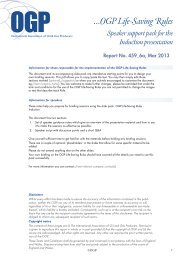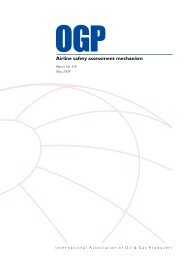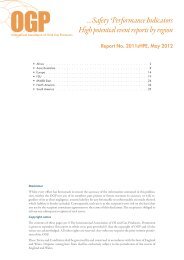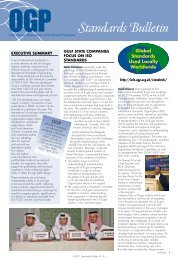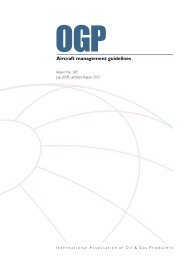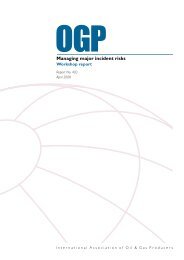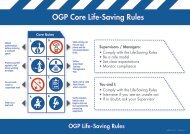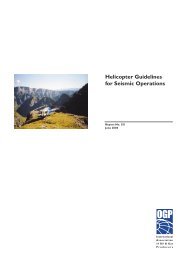Helicopter guidelines for land seismic & helirig operations - OGP
Helicopter guidelines for land seismic & helirig operations - OGP
Helicopter guidelines for land seismic & helirig operations - OGP
Create successful ePaper yourself
Turn your PDF publications into a flip-book with our unique Google optimized e-Paper software.
<strong>Helicopter</strong> <strong>guidelines</strong> <strong>for</strong> <strong>land</strong> <strong>seismic</strong> & <strong>helirig</strong> <strong>operations</strong><br />
of the flight manual as a horizontal distance and appropriate to ambient<br />
conditions.) The minimum length required <strong>for</strong> the specific type of helicopter at<br />
maximum weight <strong>for</strong> the ambient conditions can be obtained from the aircraft<br />
operator. Whenever two or more helicopter types are operated, the length of the<br />
rejected take-off area should be calculated to accommodate the most restrictive<br />
type. The minimum width of a helicopter rejected take-off area should be 2.5<br />
times the length overall of the largest helicopter with its rotors turning.<br />
3. To cover the case of an engine failure after the critical point mentioned, when<br />
the take-off would be continued on the one remaining engine <strong>for</strong> a twin engine<br />
helicopter, the take-off flight path must be cleared to a gradient in accordance<br />
with the per<strong>for</strong>mance section of the flight manual. Advice may be obtained<br />
from either the aircraft operator or company aviation advisor. A slope of 1:20 <strong>for</strong><br />
1200m horizontally may be used but only as a guideline.<br />
6.3.3 <strong>Helicopter</strong> parking areas and hangarage<br />
1. A designated parking area <strong>for</strong> each helicopter may be required. The parking<br />
area should be flat, with electrical supply <strong>for</strong> tools and flood lighting available,<br />
together with easy access to supply of clean, salt free water. Non-slip metalled or<br />
concrete surface maybe an option. Dust control along roads accessing parking<br />
area or beside parking area, may be considered when necessary.<br />
2. Depending on the local climate, remoteness and type of on site maintenance<br />
work anticipated, the construction of a (temporary) hangar should be<br />
considered.<br />
6.3.4 Helipad lighting<br />
1. Adequate lighting should be provided at the helipad and helicopter parking<br />
areas to allow inspection, preparation and loading of the helicopter in the hours<br />
of darkness. Subject to the security risk assessment <strong>for</strong> the area, peripheral<br />
security lighting should be considered and placed in a way that people<br />
approaching the aircraft will be clearly visible from a distance.<br />
2. The provision of helipad aviation lighting will depend on the decision by<br />
Company’s management on the requirement <strong>for</strong> a night evacuation capability<br />
from the base camp; normal flying <strong>operations</strong> will invariably take place only<br />
by day under Visual Flight Rules (DAY/VFR). It is emphasized that a night<br />
capability should never be assumed in the <strong>seismic</strong> environment.<br />
6.4. Communications and navigation beacons<br />
6.4.1 The minimum requirement is <strong>for</strong> duplicated equipment to ensure that helicopters,<br />
when airborne, are never out of contact with either the base camp or the local Air<br />
Traffic Control network. In many areas of the world, where such a network is basic, if<br />
it exists at all, the onus will be either of the Parties to provide appropriate coverage.<br />
6.4.2 For logistic and local advisory in<strong>for</strong>mation VHF (air band) base equipment is<br />
appropriate and, provided the area can be covered by line of sight propagation; the<br />
alternate set may also be VHF. If, however, continuous cover cannot be guaranteed<br />
then a VHF Repeater maybe a viable option, but otherwise long range HF equipment<br />
will need to be provided. Satellite voice communication, if provided by the flight<br />
tracking system can also serve as alternate communication system. “Dial in” systems,<br />
such as mobile telephones, however, are not considered adequate <strong>for</strong> this purpose.<br />
6.4.3 A designated radio frequency should be assigned to the helicopter and ground crew<br />
<strong>for</strong> flight <strong>operations</strong>.<br />
© <strong>OGP</strong><br />
19



